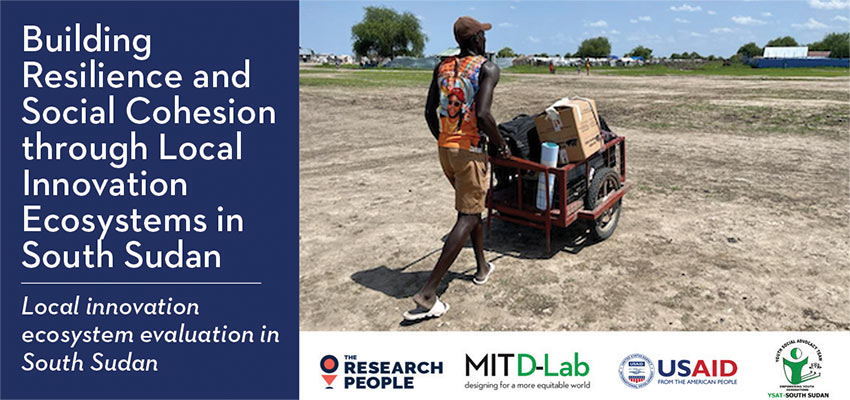
Local innovation ecosystem evaluation in South Sudan
Building Resilience and Social Cohesion through Local Innovation Ecosystems in South Sudan
Executive Summary
The Creative Capacity Building (CCB) project was a pilot project to build a local innovation ecosystem in two sites, Duk and Pibor in South Sudan, during 2022. CCB is a hands on curriculum developed at MIT D-Lab and taught by D-Lab in over 20 countries. The project aimed to train people in the design process and to apply it to developing technologies, products and services that would improve their quality of life, increase income generation, improve their agency and problem solving skills and enhance social cohesion.
This report summarises the findings of an evaluation of the project conducted during January - September 2022. It is based on primary data collected in Duk and Pibor including interviews, focus groups, observations and outcome harvesting workshops. It also draws on a document review, interviews with project staff, and survey data. The key findings included:
Knowledge and learning
- Participants valued the hands-on nature of the training and learning to do things on their own. They gained knowledge and skills in using tools, designing technologies, and in basic business skills. They felt more confident about using tools to make things if provided with materials. A small number said they could use the skills to solve problems outside the CCB setting.
- Participants felt proud of their ability to conceptualise and make technologies that solved problems. They reported positive feelings about how the training promoted agency, self reliance and confidence. There were some specific examples of how this has manifested in their lives, including in starting new businesses and improving their existing livelihoods.
Technology development
- A total of 18 technologies were built over the course of 10 CCBs. Many of the technologies were improved after the training, through informal mentoring and during a Co-Creation Event. CCB participants from both locations continued work on their prototypes, although it was most common in Pibor. Lack of materials was the biggest constraint to refining technologies.
- 44% of the technologies were being used to reduce labour by participants, their households or their communities. Participants said the technologies enabled them to simplify and speed-up common manual tasks such as carrying heavy loads (wheel cart), cooking (oven) and maize shelling.
- The technologies had a transformative effect on some people’s earnings. 44% of the technologies were being used to generate an income; participants sold or rented the technology, or used it to produce a product or provide a service. Participants used the income to meet their basic needs, pay for school fees and/or reinvest in their small businesses. In many instances the income was seasonal. Several groups had launched new businesses.
Social cohesion
- Chiefs and Local Authorities were responsible for participant selection. There were efforts to promote inclusion by delivering the training in multiple languages and providing spaces for childcare. However recruiting women was challenging (women made up 35% of participants) and there was only reference to one person with a disability attending the workshop. It was not clear how Village Chiefs and Local Authorities chose participants and if the criteria were well-aligned with the social cohesion objectives of the project.
- Women and girls reported making technologies which improved their ability to earn money, and boosted their feelings of self-reliance. Some valued contributing to their household’s financial wellbeing. Several women in Pibor also expressed more confidence in running their businesses after learning new business skills, such as in customer service.
- Participants valued that the training brought unlikely groups of people together. In Pibor, for example, people of different age-sets were able to work in the same group. Teamwork was valued as a way to generate ideas and build friendships. The majority of groups we interviewed had stayed connected to work together on their technologies (or run their businesses).
Co-creation event
- Four technologies were refined at the Co-Creation event. The event had a significant impact on CCB participants’ confidence to earn an income and use the design process to build technologies and solve problems in their lives. By the end of the Event, all but one participant said they felt ‘somewhat’ or ‘very confident’ building things out of wood and metal.
- The majority of the participants valued working with people from different communities. All participants reported working with someone who was different to them by age, gender, ethnic group or occupation and several expressed a transformation in how they thought about rival groups. Participants described the Event as an opportunity to exchange ideas, including about other cultures.
The CCB model
- Strong relationships were built between MIT D-Lab and YSAT (based in Juba), and with the Centre Managers and Facilitators in Pibor and Duk. These relationships were key to the good performance of the project.
- Overall, people said they felt comfortable in the centre, despite most travelling long distances and working long hours on their prototypes. Several commented that they enjoyed sitting and eating together or mentioned that it was a nice shady environment.
- However, there were significant implementation challenges including facilitator turnover in Pibor, difficulties moving in the rainy season, difficulties transporting supplies, and a tight project timeline. These affected the set-up of the innovation centres, ongoing mentoring, and business training. Participants noted delays in accessing materials and difficulty fixing technologies that broke.
More information
MIT D-Lab Humanitarian Innovation Program
Contact
Martha Thompson, MIT D-Lab Humanitarian Innovation Specialist

